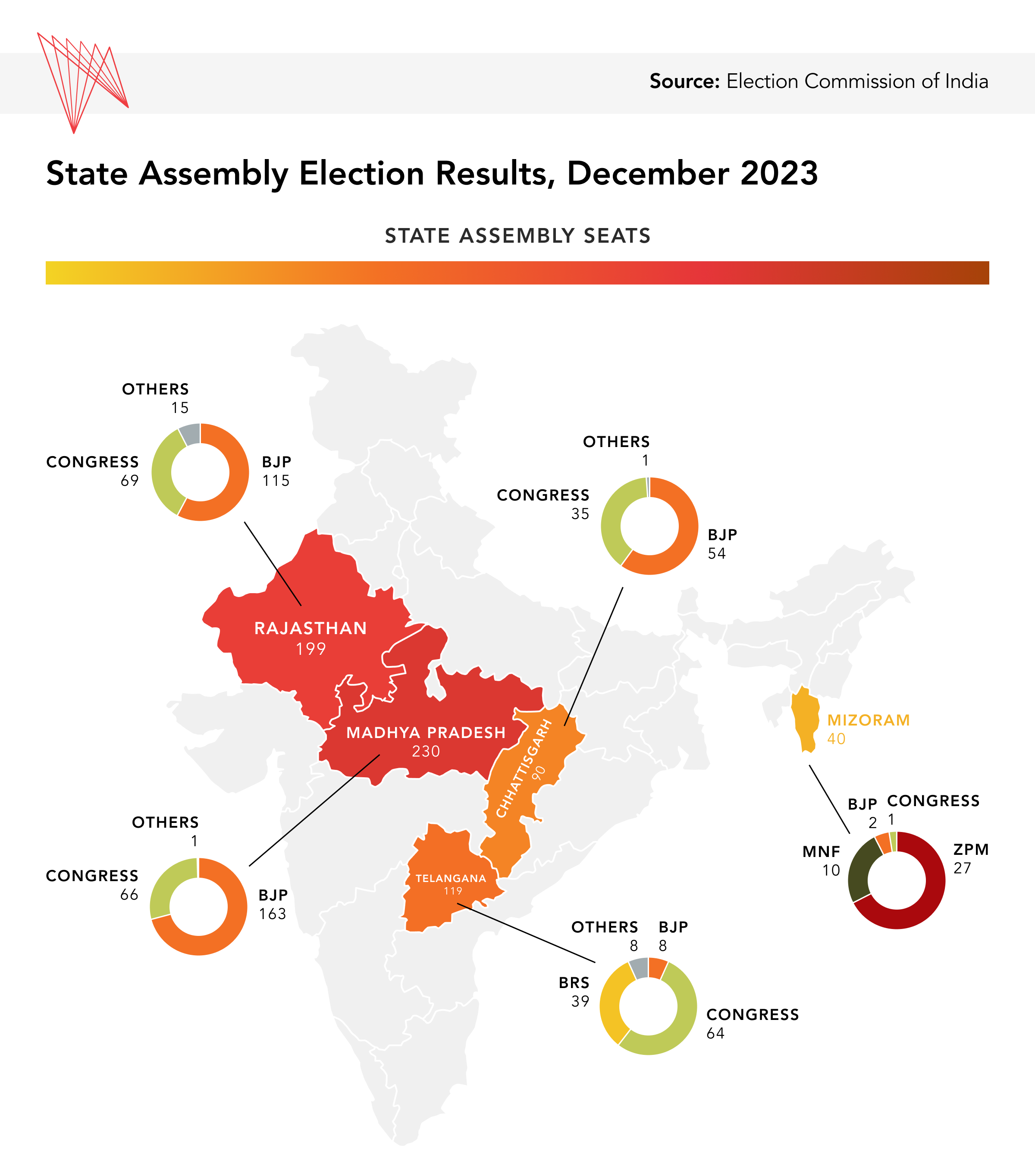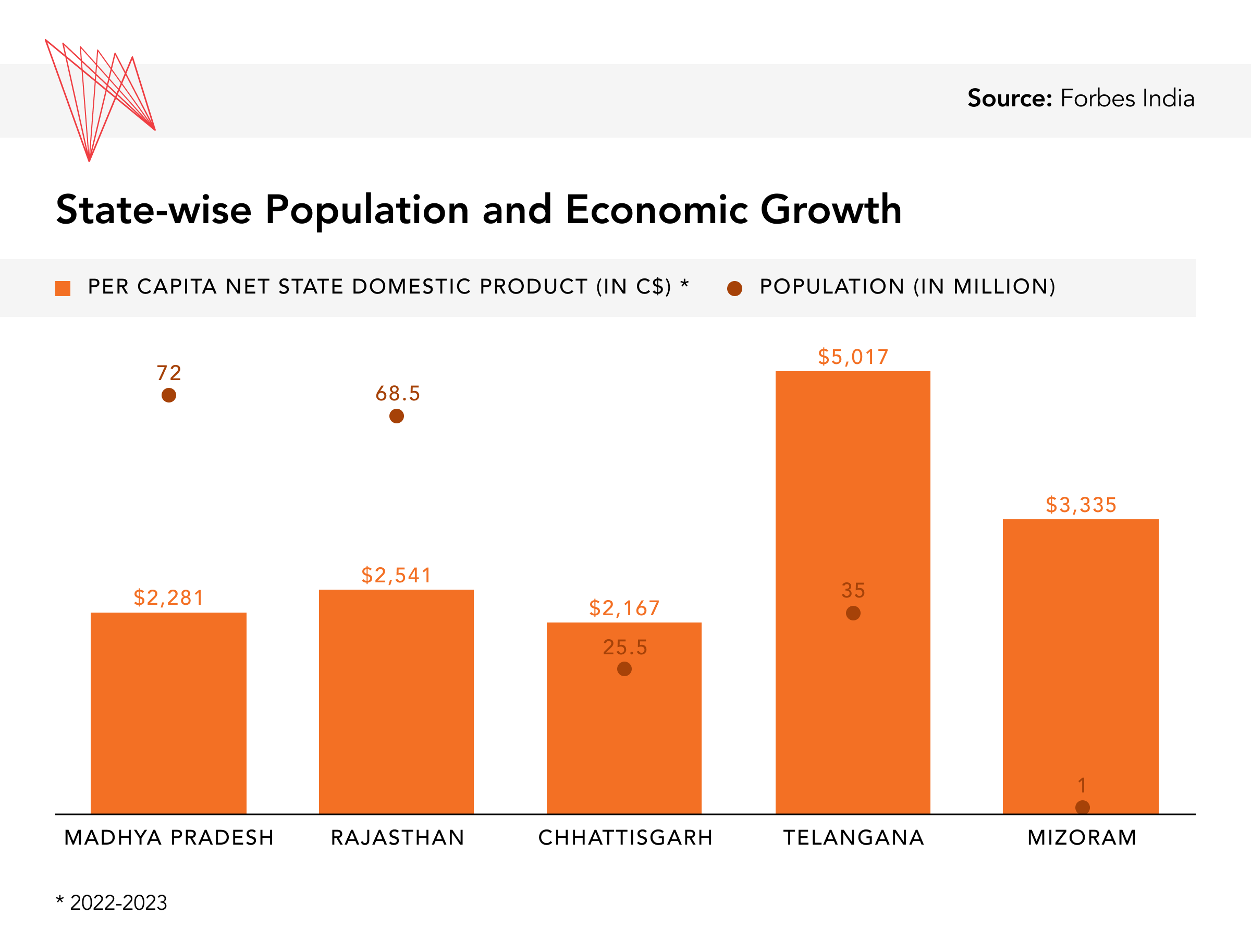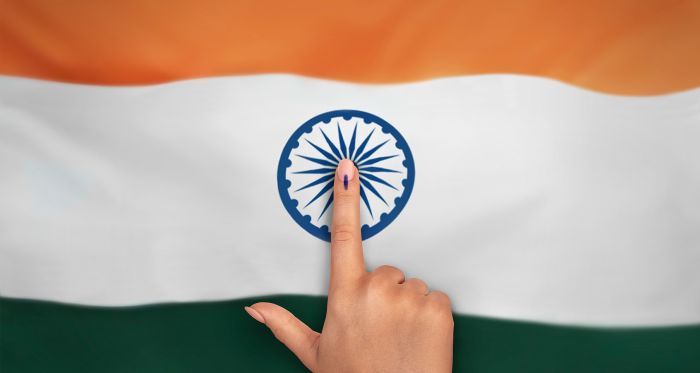In the past year, India has solidified its status as a major economic and geopolitical power and is increasingly regarded as a vital counterbalance to China in the Indo-Pacific. But India’s domestic political forces are not well known or understood outside of India, including in Canada. Domestic factors, such as its economic policies and its democratic trajectory, are, nonetheless, closely tied to its success as a rising global power. Policies related to economic growth and international trade are also frequently influenced by state-level factors, thus making state governments in India important players to consider.
Recent elections in five Indian states – Madhya Pradesh, Rajasthan, Chhattisgarh, Telangana, and Mizoram – not only contain valuable insights on socio-economic factors based on religion, caste, and gender, that shape the ruling Bharatiya Janata Party’s (BJP) popularity vis-à-vis the Congress, the main opposition party, but also serve as a kind of “semifinal” in the lead up to the country’s next round of national parliamentary elections in April-May 2024.
What can we glean from these state election results – about the electoral strength of the ruling BJP, led by Prime Minister Narendra Modi; about significant regional differences; and the extent to which Hindutva, or Hindu nationalism, animates voters – or not
What were the results, and why do they matter?
On December 3-4, the BJP secured big victories in three of India’s five state elections: Madhya Pradesh (163 out of 230 seats), Rajasthan (115 out of 119 seats), and Chhattisgarh (54 out of 90 seats). Congress pulled out a win in the southern state of Telangana (64 out of 119 seats), and voters in the small state of Mizoram in the far northeast of the country elected an upstart party, the Zoram People’s Movement (ZPM), with 27 of the 40 state assembly seats

Although voter preferences in state elections often vary from national elections, the recent state elections, mere months before the 2024 national elections, were an opportunity for parties to make headway. These five states will send a combined 83 members of parliament (MPs) to the 543-member Lok Sabha, the lower house of the Indian parliament. They were also a useful bellwether of the mood of the electorate.
India’s political system at a glance:
-
Like Canada, India is a multi-party parliamentary democracy that follows the first-past-the-post electoral system – that is, the party that wins a simple majority takes power. The central government, headed by the prime minister, is formed by the largest party in the Lok Sabha, the lower house of parliament.
-
National-level competition in the last two decades has primarily been between two main parties: the centrist Indian National Congress (or Congress) and the right-wing Hindu nationalist Bharatiya Janata Party (BJP), in alliance with several regional partners.
-
At the state level, regional parties are also vital players. State governments are formed by the largest party in the Vidhan Sabha, or state legislative assembly, and are headed by a chief minister.
Despite the BJP’s national-level dominance, pre-election punditry identified several hurdles for the party due to a two-year high unemployment rate of 10 per cent, inflation running at six per cent, allegations of cronyism stemming from the suspected ties with the infrastructure conglomerate Adani Group, and corruption charges against BJP state governments. Adding to the BJP’s worries, 28 political parties across the country united under the Congress’s leadership in July 2023 to form an anti-BJP alliance, the Indian National Developmental Inclusive Alliance, or INDIA.
BJP and India’s Hindi-heartland:
-
Rajasthan, Madhya Pradesh, and Chhattisgarh are part of the BJP’s stronghold in India’s north and west, a region often referred to as the ‘Hindi heartland’ due to the dominance of Hindi speakers. This Hindi-belt is also where the BJP’s Hindu nationalism (or Hindutva) catapulted it to national prominence in the 1990s. The region is thus alternately called the ‘cow belt,’ as the cow, sacred to Hindus, symbolizes the Hindu nationalist movement.
-
The Hindi-belt plays a pre-eminent, king-maker role in Indian politics, even though the southern states fare better on socio-economic development. While the BJP’s winning streak in the Hindi-belt states shows a clear momentum in its favour, the party struggles to find traction in the south.
What, then, explains the BJP’s stellar performance in these state elections? Firstly, the personal popularity of Prime Minister Modi, combined with ‘Hindutva’ – or Hindu nationalism – buttressed its position in the ‘Hindi-heartland.’ The party could capitalize on Hindutva as a project of cultural revival and Modi as its charismatic leader, propelling India as the next viswa guru, or global power. Furthermore, the BJP has successfully widened its social base to include women, marginalized caste groups like ‘Other Backward Classes’ (OBCs), and tribes.
In contrast, the Congress suffered from the lack of a viable alternate social vision despite trying to recover OBC voters with larger ‘quotas’ following a proposed nationwide caste survey. On the issue of economic policies, the pre-electoral offering of both parties constituted a similar policy of welfarism (or “competitive welfarism”) but nationwide growth levels bolstered the BJP’s credentials.

Key trends from five states:
-
Madhya Pradesh – A combination of ‘freebie,’ a divided opposition, and Hindutva keep the BJP afloat
Defying all expectations that incumbents would be voted out after 18 years in power, the BJP held on with a big victory in Madhya Pradesh. The party’s success is attributable to a combination of welfare schemes, rivalries within the opposition’s INDIA alliance, and the ideological dominance of Hindutva in the Hindi-belt, which even the Congress sought to emulate.
‘Ladli Behen Yojana,’ a welfare program providing eligible women with a monthly stipend of 1,250 rupees (C$20), was a last-minute game changer for the BJP. The results in Madhya Pradesh exemplify the one-upmanship that increasingly defines electoral competition in India, with parties offering competing socio-economic welfare schemes, such as free food grains and electricity, that critics somewhat disdainfully refer to as ‘freebies.’ These ‘freebies,’ however, are effective in drawing support among rural and women voters, because they provide immediate relief to distressed households.
The Congress party’s woes in this state election included fissures in the opposition’s INDIA alliance over differences about seat sharing with its political partners. Furthermore, the results show that the Congress’s ad hoc strategy of appealing to Hindu voters with a copycat version of Hindu nationalism, called ‘soft Hindutva,’ has not been able to dent the BJP’s Hindu support base.
-
Rajasthan – The Modi factor shines brightly
Since 1993, political power in Rajasthan has alternated between the Congress and the BJP. For the incumbent Congress government, beset by factional rivalries, its welfare schemes, particularly its flagship 50 lakh rupees (C$81,000) health insurance guarantee, underpinned its hopes for claiming a second consecutive term. The BJP, however, was able to attract voters with its own welfare policies, such as free food grains, and presented these policies as a personal guarantee of the prime minister with slogans of “Modi ki guarantee” (Modi’s guarantee).
Like Rajasthan, the BJP’s political strategy in all recent state elections has been to piggyback on Modi’s popularity. The prime minister enjoys a special appeal among female voters in all three states won by the party due to the focus on women-centred policies such as cooking gas subsidies, parliamentary quotas for women, and others, with Modi as the face of these policies. He has also not shied away from claiming the title of ‘Hindu hriday samrat,’ the ruler of Hindu hearts. Modi’s appeal in state elections is also driven by the BJP’s success in convincing voters that the same party governing at both the national and state level would allow for policy continuity and better policy delivery.
-
Chhattisgarh – Congress loses the support of marginalized caste and tribal voters
In Chhattisgarh, the Congress government was voted out of power due to its failure to hold on to its traditional social base of marginalized caste and tribal voters. The biggest blow to the party came from the Adivasi (tribal) regions where the outgoing government dragged its feet in implementing local self-governance, denied tribal Adivasi communities control over their land and natural resources and allowed big corporations like the Adani Group to continue mining operations despite opposition from local Adivasis.
A major grievance of Christian Adivasis against the Congress government going into the state elections was grounded in the party’s inept response to the BJP’s allegations of forced conversions by Christian groups and the consequent violence against Christian Adivasis. In Surguja and Bastar, predominantly tribal regions, the BJP won almost 90 per cent of the seats.
Moreover, the Congress’s main poll strategy of a ‘caste-based census’ ahead of 2024 to reclaim the support of marginalized caste groups, such as OBCs, failed to generate traction in these state elections. A caste-based census would enumerate the population size of different caste groups and is a political shorthand for Congress’s demands of expanding reservation policies for OBCs.
-
Telangana – Reflective of how southern states differ from the Hindi-belt
Congress did pull off a win in the southern state of Telangana, unseating the regionally dominant party, Bharat Rashtra Samithi (BRS). The win in Telangana provides Congress with some redemption, especially given the party’s third-place showing in the state in the 2019 parliamentary elections, behind both the BRS and the BJP. The Congress party’s resurgence in 2023 is attributed to its de facto leader Rahul Gandhi’s Bharat Jodo Yatra, a 4,000-kilometre march held between September 2022 and January 2023 against “divisive politics,” along with the general weakness of Hindutva in the south. Like its victory in the state of Karnataka in May 2023, Congress’s Telangana win also suggests that southern voters prioritize “bread and butter issues” such as economic welfarism and development over identity politics. After its loss earlier in Karnataka, the BJP does not directly govern any of the southern states.
-
Mizoram – The northeastern state votes for change
The newest party in the northeastern state, the ZPM, rode to power on a narrative of change in Christian-majority Mizoram. In the run-up to the elections, Congress and the outgoing Mizo National Front (MNF), which is allied with the BJP at the national level, raised concerns about ethnic violence in neighbouring BJP-ruled Manipur. The lacklustre performance of the Congress and the MNF reflects how the issue has not had an impact on the electorate.
The road to India’s national elections
As the world’s largest democracy prepares for its next national elections in April-May 2024, results from the five states, though not a perfect predictor of what lies ahead, provide a glimpse of regional differences and the socio-economic issues that resonate with Indian voters. They also show that the BJP is on strong ground to secure the rare feat of a third term for Narendra Modi as prime minister. The party is particularly well-positioned in the Hindi-belt states with Hindu nationalism as the salient political ideology, although it is not driving the narrative in the south of the country.
Cracks in the opposition’s INDIA alliance and the erosion of support for the Congress party among its conventional voter base of marginalized castes and tribes also seem to have brightened the BJP’s prospects in 2024. This greater acceptance of the BJP among marginalized castes, tribal groups, and women voters reflects the party’s expanding social base, building on its traditional Hindutva-based support.





